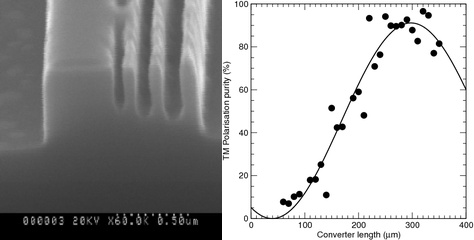Integrated Polarisation Manipulation and Control
We have demonstrated low-loss reciprocal polarisation mode conversion based on an asymmetric profile rib waveguide using a single wafer etch step. One approach used an angled etch in a custom sample holder, and was successfully integrated with a semiconductor laser to provide a multiply-polarised output. The second approach utilises the Reactive Ion Etch Lag phenomenon with a conventional dry-etching configuration, as shown below. 50% polarisation conversion was achieved with an optical loss of only 0.6~dB. The ability for the RIE lag structures to be tapered allows for a smooth transition when integrating with other waveguide elements.

We have identified that a wide range of polarisation functional devices require a 50% reciprocal polarisation mode converter, including an integrated optical isolator which can be constructed by combining such a 50% reciprocal polarisation mode converter with a 50% non-reciprocal (magneto-optic) mode converter. Rather than use a quarter-beat-length of a 100% converter, a design which can only be approached asymptotically with increasingly tight tolerances, we have identified that a half-beat-length of a 50% converter will suffice (equivalent to a waveplate orientated at 22.5 or 67.5 degrees to the wafer). The figure below shows the calculated mode profiles in terms of the Stokes parameters for such a 50% reciprocal polarisation mode converter in an Al-quaternary wafer for a wavelength of 1550nm. The asymmetry is provided by a single etched trench whose depth is defined by an etch-stop layer.

An integrated polarisation modulator can be achieved by concatenating reciprocal polarisation mode converters and differential phase sections (which could be based on the quantum confined Stark effect or current injection in a quantum well structure). With appropriate phase shifts the transformations of TE-polarisation to any defined polarisation state (modulator), and given polarisation state to TE (aligner) or any given to any other polarisation state can be achieved.

The integration of this form of polarisation modulator with a laser was covered in this optics.org article.
People
- Prof. David C. Hutchings
- Dr. Barry M. Holmes
- Dr. Josef Bregenzer
- Dr. Steven McMaster
- Dr. Marc Sorel
- Prof. John H. Marsh
- Dr. Tony Kelly
Publications
- Naeem, M. A., Haji, M., Holmes, B., Hutchings, D. , Marsh, J. and Kelly, A. (2015) Generation of high speed polarization modulated data using a monolithically integrated device. IEEE Journal of Selected Topics in Quantum Electronics, 21(4), 3400205.(doi:10.1109/JSTQE.2014.2375492)
- B. M. Holmes, M. A. Naeem, D. C. Hutchings, J. H. Marsh, and A. E. Kelly, A semiconductor laser with monolithically integrated dynamic polarization control, Optics Express, Vol. 20, Issue 18, pp. 20545-20550 (2012). DOI: 10.1364/OE.20.020545
- Hutchings, D.C. and Holmes, B.M. (2011) A Waveguide Polarisation Toolset Design based on Mode-Beating, IEEE Photonics Journal, 3 (3) pp. 450-461 DOI: 10.1109/JPHOT.2011.2146765
- Bregenzer, J.J., McMaster, S., Sorel, M., Holmes, B.M. and Hutchings, D.C. (2009) Compact polarization mode converter monolithically integrated within a semiconductor laser. Journal of Lightwave Technology, 27 (14) pp. 2732-2736.
- Holmes, BM and Hutchings, DC (2006) Realization of novel low-loss monolithically integrated passive waveguide mode converters. IEEE Photonics Technology Letters, 18 pp. 43-45.
Theses
Project Support
- Integrated Waveguide Polarisation Controller project supported under EPSRC Knowledge Transfer Account EP/H500138/1
- EPSRC GR/S10599/01: Monolithic-Integrated Optical Devices Containing Magneto-Optic Elements

